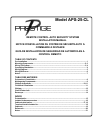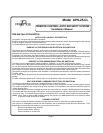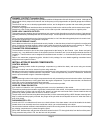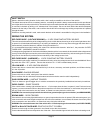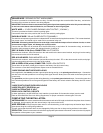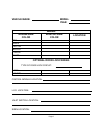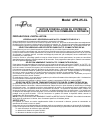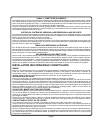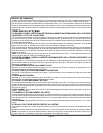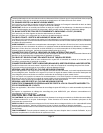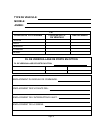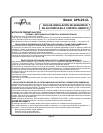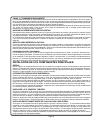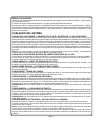
Page 2
DASH MOUNTED L.E.D.:
A small red L.E.D. is included that will serve as a visual indicator of the alarm status. It should be installed in the dash,
located where it can be easily seen from outside the vehicle, yet not be distracting to the driver.
Once a location has been selected, check behind the panel for wirerouting access, and to confirm the drill will not damage
any existing components as it passes through the panel.
Drill a 15/64" diameter hole, and pass the red and blue wires from the L.E.D. through the hole, from the front of the panel.
Firmly press the body of the L.E.D. into the hole until fully seated.
CHANNEL 3 OUTPUT (Transmitter Only):
The transmitters included in this alarm incorporate an additional independent 3rd radio frequency channel. Although the
alarm module will only respond to 2 channels, the 3rd frequency can be programmed to an optional garage door interface
(AS-9154).
The AS-9154 has its own on-board programmable receiver, and is designed to operate with most existing automatic
garage door openers.
In addition, the garage door interface receiver can be directly wired into the vehicle to offer a third remote control option.
Since this is a set of relay contacts, the receiver can be used to provide a selectable positive or negative pulse.
DOOR LOCK / UNLOCK OUTPUTS:
This system provides negative (ground) pulsed door lock outputs, which allows direct connection to some (3 wire ground
switched) OEM factory installed power door lock control relays. These outputs have a maximum current capability of 300
mA.
When connecting to vehicles that use a 3 wire positive switched, or 4 or 5 wire alternating polarity door lock control circuit,
the optional AS-9159 Door Lock Interface is required.
FUTURE REFERENCE CHART:
As an added convenience to the professional security installer, a chart has been printed in this guide for recording wire
colors, component mounting locations, and any other useful tips particular to the vehicle you are working on. Taking a
few extra moments on each installation to fill in the chart, can save you valuable time in the future.
TRANSMITTER PROGRAMMING:
The transmitters included in this kit have been programmed at the factory for the Channel 1 (arm, disarm and panic
function) only. Any additional functions of the system (receiver Channels 2 and 3) must be programmed at the time of
installation. These functions can be assigned to transmitter button number 2, or a simultaneous press of both buttons
1 and 2.
Refer to the transmitter programming guide, included in this package, for more details regarding transmitter button
assignments and system functions.
HOOD OR TRUNK PIN SWITCH:
A pin switch is included for use in protecting the hood or trunk (or hatchback) of the vehicle.
The switch must always be mounted to a grounded, metal surface of the vehicle. It is important to select a location where
water cannot flow or collect, and to avoid all drip “gutters” on hood and trunk fender walls. Choose locations that are
protected by rubber gaskets when the hood or trunk lid is closed.
The pin switch can be mounted using the bracket provided, or direct mounted by drilling a 9/32" diameter mounting hole.
Keep in mind that when properly mounted, the plunger of the pin switch should depress at least 1/4" when the hood or
trunk lid is closed.
SIREN:
Select a mounting location in the engine compartment that is well protected from access below the vehicle. Avoid areas
near high heat components or moving parts within the engine compartment. To prevent water retention, the flared end
of the siren must be pointed downward when mounted.
Mount the siren to the selected location using the screws and bracket provided.
CONTROL MODULE:
Select a mounting location inside the passenger compartment (up behind the dash), and secure using two screws
provided.
The control module can also be secured in place using cable ties.
Do not mount the control module in the engine compartment, as it is not waterproof. You should also avoid mounting the
unit directly onto factory installed electronic components. These components may cause RF interference, which can
result in poor transmitter range or intermittent operation.
INSTALLATION OF MAJOR COMPONENTS:



